How a Dirty Paper Towel Changed My View of the Matterhorn Vent
Traducción al español a continuación.
I am a geochemist. My primary job on this cruise is to collect hydrothermal fluids from the vents and rocks that make up the chimneys and mounds. These hydrothermal chimneys form from the cooling of hot water when it vents into the cold seawater. You pick up some general rules to guide you when you have been doing geochemistry at sea for a few decades. Rules such as:
- “You can never be too clean.” You want the elements you analyze to come from the fluids and rocks, not some contamination.
- “No sample is too small to be ignored.” Samples from the deep sea are hard to come by.
- “Things don’t always work as planned.” Do the best with what you’ve got.
Some Results from Previous Dive Cruises to Pescadero Basin
Based on samples I’ve taken at this vent field previously, I knew that almost all of the hydrothermal mounds in the Pescadero Basin are made of calcite (CaCO3). The calcite minerals found here contain elevated, but still low, levels of copper (Cu), Zinc (Zn), and iron (Fe) relative to non-hydrothermal carbonate. Areas with active hydrothermal flow (chimneys, flanges) also have abundant anhydrite (CaSO4). A few samples collected previously from near the Matterhorn Chimney, an isolated vent on the SW border of the Auka vent field, were different from others in the area. They are composed of the mineral barite (BaSO4), with no Cu or Zn, but unusually high levels of gold, silver, and antimony. A big, on-land deposit with similar concentrations of precious metals would be considered a very rich ore deposit, but the value of the metals is not even close to what it would cost to try to mine them from the seafloor.
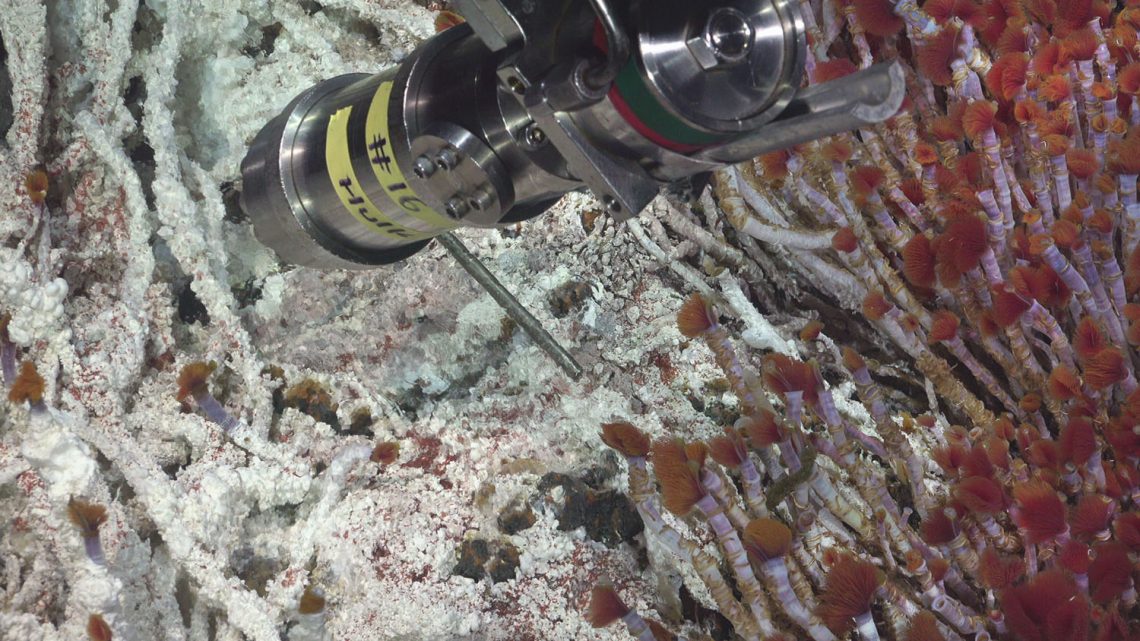
Plans for this Cruise
One of my goals for this cruise was to sample hydrothermal fluids and rock samples from the top of the Matterhorn chimney and see if they are forming calcite and anhydrite, like all the other vents, or if are the forming barite. Easy. Well, easy enough for me to ask the ROV pilots to get me the samples I want, but unfortunately that is where the easy ends. Balancing an ROV on top of a chimney spewing nearly 200°C water and trying to maneuver the manipulator through a hedge of tubeworms while looking through shimmering water to place a sampling bottle nozzle exactly in the right place… is anything but easy (Fig 1).
The Real World of Sampling Vents
I often ask the ROV pilots to do the difficult to near impossible, and it is surprising how often they succeed, but sometimes the impossible really isn’t possible. On Dive 467 the pilots managed to fire two of the sampling bottles we use for analyzing gases dissolved in the vent fluid, but we were not able to get a fluid sample in the major element sample bottles, and we had to leave the vent before we could get a rock sample from the top. That’s how it goes sometimes. Maybe soon we’ll get a chance on a future dive to answer our questions, as the routine after the dive to clean the water sampling bottles and prepare them for the next day.
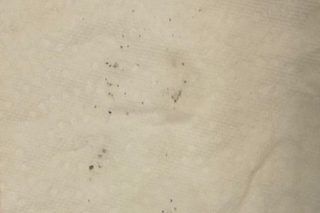
Unanswered Questions Linger in the Mind
After cleaning the water bottles and flushing out sample nozzles, I noticed there was a tiny amount of silt-size grains in the bottom of the sink. Because I keep a clean lab (Rule 1), I knew the ‘dirt’ in the sink came from the top of the chimney. Should I bother trying to look at a few grains of dirt? I slurped up some of the grains in a syringe (Rule 2), put them on a paper towel to dry (Fig 2), and decided to look at them with a microscope (Rule 3).
Taking a Second Look
A good geologist can identify many minerals by their different properties, including the shape and symmetry of the crystal. So, what did I see under the microscope? Barite! Based on these few tiny grains of grit that I almost washed down the drain, I am feeling more confident that the Matterhorn chimney is different than the rest of the chimneys in the vent field. Now I am more interested than ever to try to get a water and rock sample from the top of this chimney so I can try to understand why there is barite there.
What’s Next?
I am not sure if we will get a second opportunity to attempt sampling the Matterhorn vent on Leg 3, and even if we do, there is no guarantee that ROV pilots will be able to perform another one of their magic tricks. However, I have no doubt they will give it their best effort. Maybe I’ll get lucky next time?
Rule Four
And if you live a clean life, pay attention to small details, and make the best of what life gives you, maybe you can get to the top of the next mountain you need to climb. Rule #4 is ‘you’re more likely to succeed if you’re surrounded by a good team.’ That is why I am out here on the R/V Falkor!
Spoiler Alert!
The blog above was written at the end of Leg 2. The first dive of Leg 3 returned to the Matterhorn and 1) the pilots still have their magic and I now have a water sample from the top of the Matterhorn, 2) rocks collected from the area where water is venting are massive barite with trace amounts of the mineral stibnite (Sb2S3) and will likely prove to be silver-rich when analyzed. So, we have answer one question, the Matterhorn is made of different minerals than the other big hydrothermal chimneys. When we analyze the water samples back in the lab we can try to address the new questions raised, like what is different about the fluids and what does this tell us about the subsurface geology? Answering a scientific question invariably raises new questions. Science will never be limited by our accumulated knowledge and can only be limited by a lack of curiosity. It’s a never ending story.
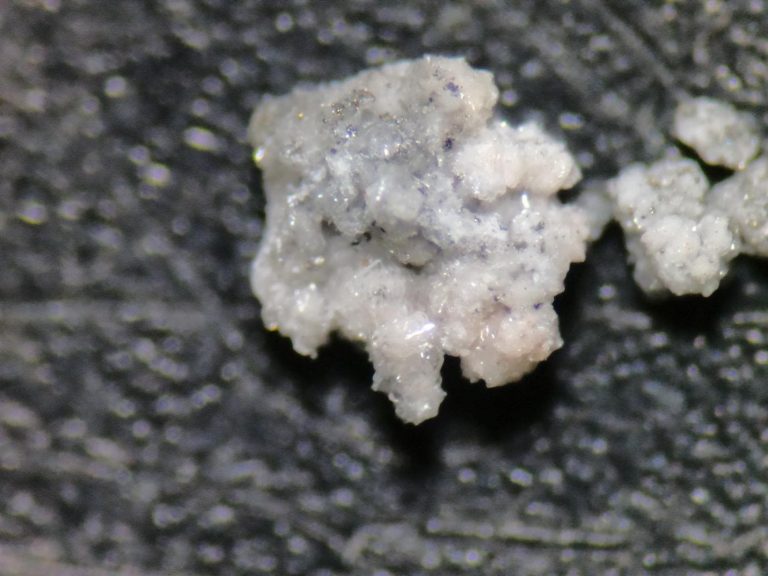
UNA MONTAÑA EN UN GRANO DE ARENA
O
Cómo una toalla de papel sucia cambió mi visión del Matterhorn
Soy geoquímico. Mi trabajo principal en este crucero es recoger los fluidos hidrotermales de los respiraderos y las rocas que forman las chimeneas y los montículos. Estas chimeneas hidrotermales se forman a partir del enfriamiento del agua caliente cuando se encuentra con el agua de mar fría. Cuando uno lleva varias décadas haciendo geoquímica en el mar, adquiere algunas reglas generales que le sirven de guía. Reglas como:
- “Nunca puede estar demasiado limpio”, quieres que los elementos que analizas provengan de los fluidos y las rocas, no de alguna contaminación.
- “Ninguna muestra es demasiado pequeña para ser ignorada”, las muestras de las profundidades marinas son difíciles de conseguir.
- “Las cosas no siempre funcionan como se planean”, haz lo mejor con lo que tienes.
Algunos resultados de anteriores expediciones a la cuenca del Pescadero
Basándome en las muestras que he tomado anteriormente en este campo de fumarolas, sabía que casi todos los montículos hidrotermales de la cuenca de Pescadero están hechos de calcita (CaCO3). Los minerales de calcita que se encuentran aquí contienen niveles elevados, aunque bajos, de cobre (Cu), zinc (Zn) y hierro (Fe) en relación con el carbonato no hidrotermal. Las zonas con flujo hidrotermal activo (chimeneas, bridas) también tienen abundante anhidrita (CaSO4). Unas pocas muestras recogidas anteriormente en las proximidades de la chimenea Matterhorn, un respiradero aislado en el límite suroeste del campo de respiraderos de Auka, eran diferentes de las demás de la zona. Están compuestas por el mineral barita (BaSO4), sin Cu ni Zn, pero con niveles inusualmente altos de oro, plata y antimonio. Un gran yacimiento terrestre con concentraciones similares de metales preciosos se consideraría un depósito mineral muy rico, pero el valor de los metales no es ni siquiera cercano a lo que costaría intentar extraerlos del fondo marino.
Planes para este crucero
Uno de mis objetivos para este crucero era tomar muestras de fluidos hidrotermales y rocas de la parte superior de la chimenea del Cervino y ver si están formando calcita y anhidrita, como todas las demás chimeneas, o si están formando barita. Es fácil. Bueno, fácil para mi porque solo tengo que pedir a los pilotos del ROV que me traigan las muestras que quiero, pero desgraciadamente ahí acaba lo fácil. Balancear un ROV en la parte superior de una chimenea que arroja agua a casi 200°C y tratar de maniobrar el manipulador a través de una comunidad de gusanos tubulares mientras se mira a través del agua brillante para colocar una boquilla de la botella de muestreo exactamente en el lugar correcto… Es todo menos fácil (Fig. 1).
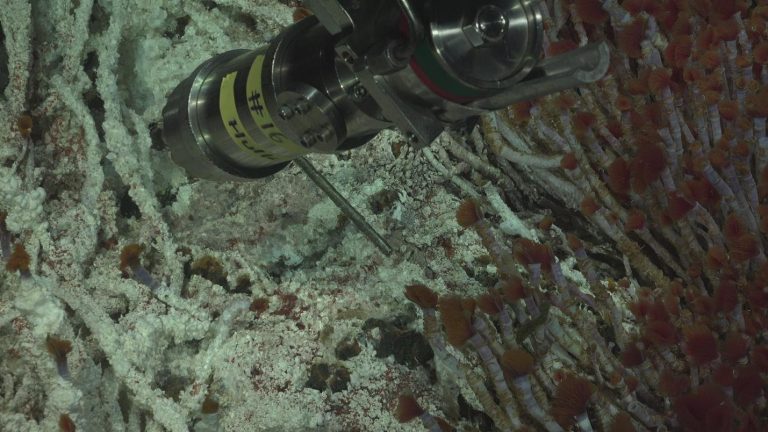
El mundo real del muestreo de respiraderos
A menudo pido a los pilotos del ROV que hagan lo difícil o lo casi imposible, y es sorprendente la frecuencia con la que lo consiguen, pero a veces lo imposible realmente no es posible. En la inmersión 467, los pilotos consiguieron disparar dos de las botellas de muestreo que utilizamos para analizar los gases disueltos en el fluido de los respiraderos, pero no pudimos obtener una muestra de fluido en las botellas de muestreo de elementos principales, y tuvimos que abandonar el respiradero antes de poder obtener una muestra de roca de la parte superior. Así son las cosas a veces. Tal vez pronto tengamos la oportunidad en una futura inmersión de responder a nuestras preguntas, como la rutina después de la inmersión para limpiar las botellas de muestreo de agua y prepararlas para el día siguiente.
Las preguntas sin respuesta persisten en la mente
Después de limpiar las botellas de agua y enjuagar las boquillas de muestreo, me di cuenta de que había una pequeña cantidad de granos del tamaño del limo en el fondo del fregadero. Como mantengo un laboratorio limpio (regla 1), sabía que la “suciedad” del fregadero procedía de la parte superior de la chimenea. ¿Debía molestarme en mirar unos pocos granos de suciedad? Sorbí algunos de los granos en una jeringa (Regla 2), los puse en una toalla de papel para que se secaran (Figura 2), y decidí mirarlos con un microscopio (Regla 3).
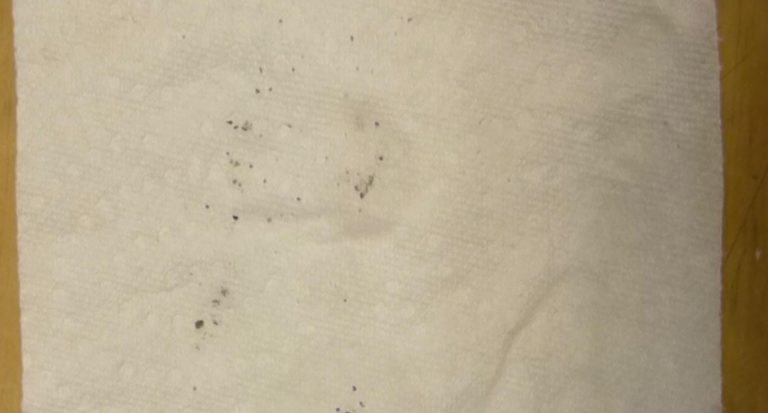
Una segunda mirada
Un buen geólogo puede identificar muchos minerales por sus diferentes propiedades, incluyendo la forma y la simetría del cristal. ¿Qué he visto bajo el microscopio? Barita. Basándome en estos diminutos granos de arenilla que casi he tirado por el desagüe, me siento más seguro de que la chimenea del Matterhorn es diferente al resto de las chimeneas del campo de ventilación. Ahora estoy más interesado que nunca en tratar de obtener una muestra de agua y roca de la parte superior de esta chimenea para tratar de entender por qué hay barita allí.
¿Qué sigue?
No estoy seguro de si tendremos una segunda oportunidad de intentar tomar muestras de la chimenea Matterhorn en la etapa 3, e incluso si lo hacemos, no hay garantía de que los pilotos del ROV sean capaces de realizar otro de sus trucos de magia. Sin embargo, no me cabe duda de que se esforzarán al máximo. ¿Tal vez tenga suerte la próxima vez?
Regla 4
Si vives una vida limpia, prestas atención a los pequeños detalles y aprovechas al máximo lo que te da la vida, quizá puedas llegar a la cima de la próxima montaña que tengas que escalar. La regla nº 4 es que “es más probable que tengas éxito si te rodeas de un buen equipo”. ¡Por eso estoy aquí en el R/V Falkor!


